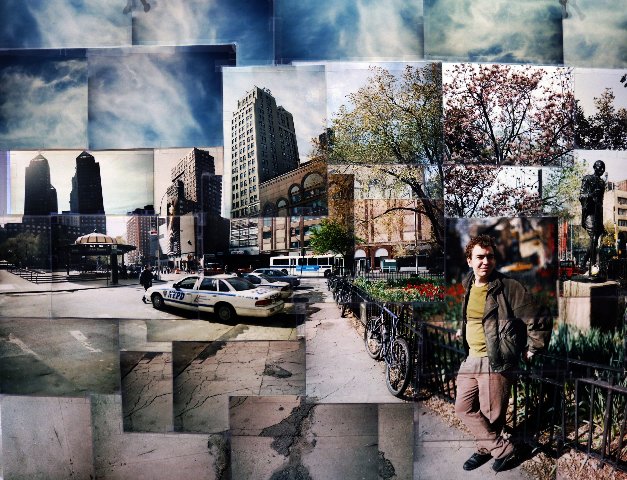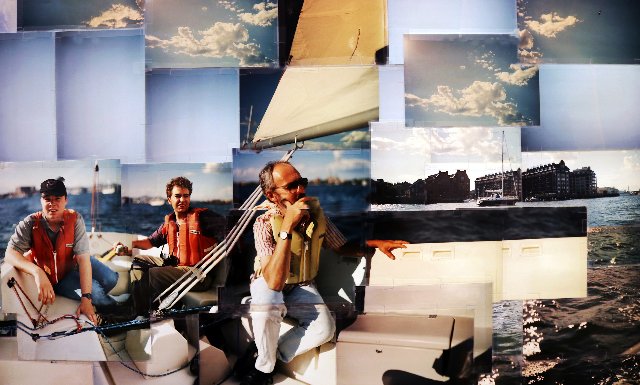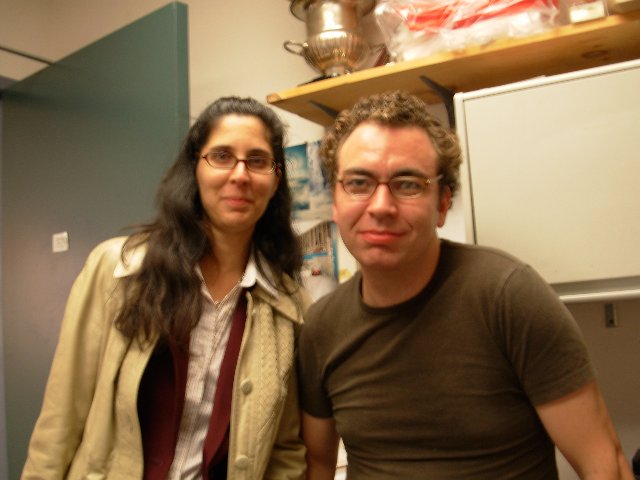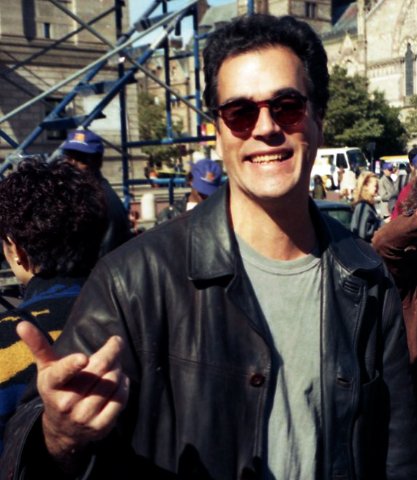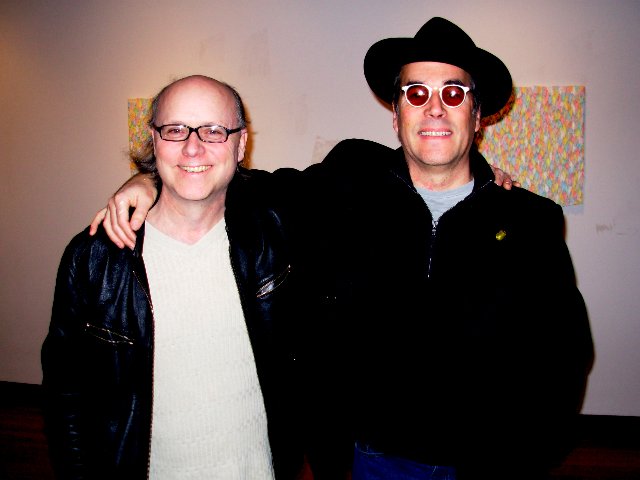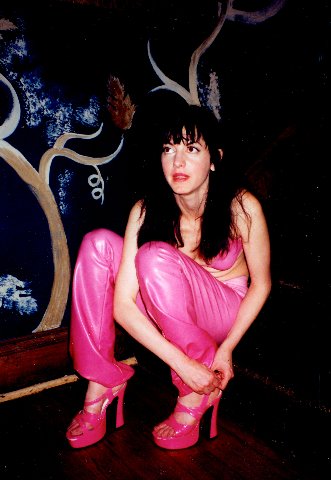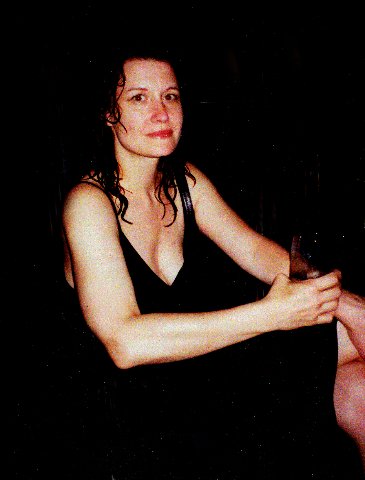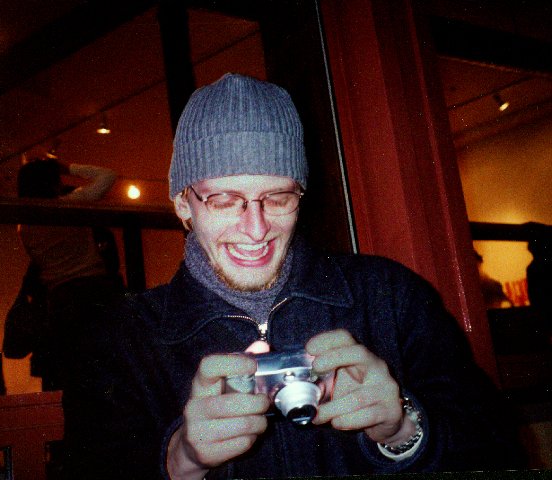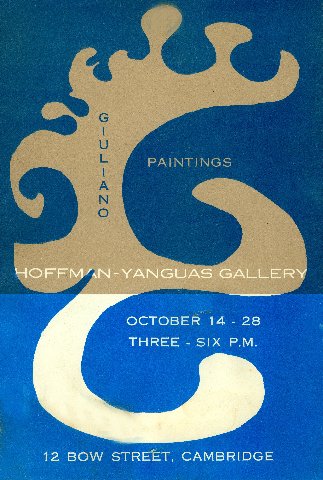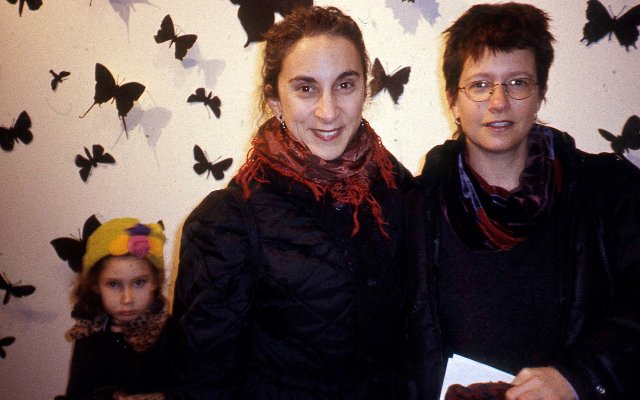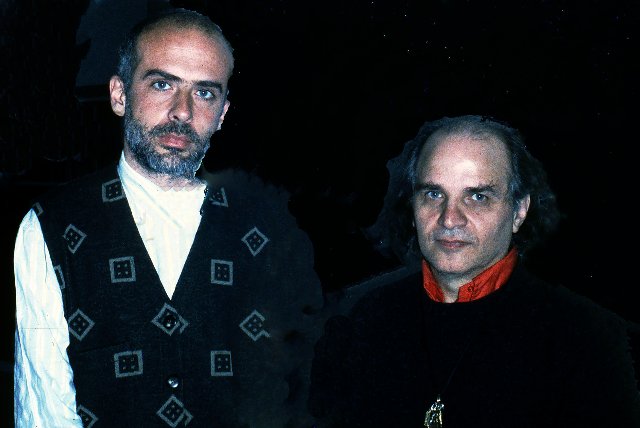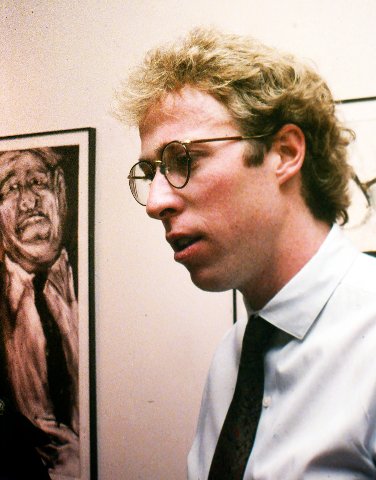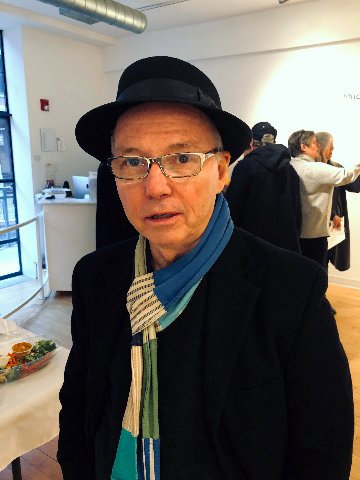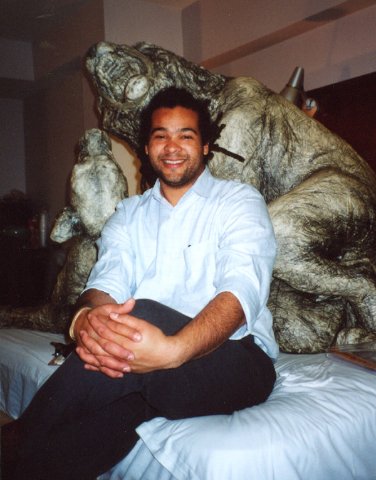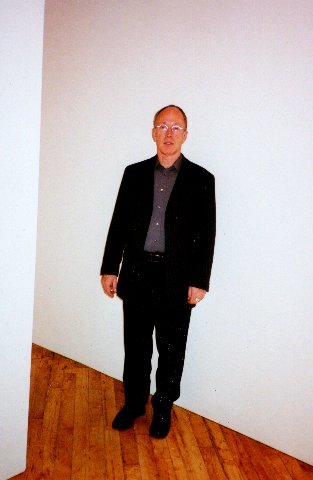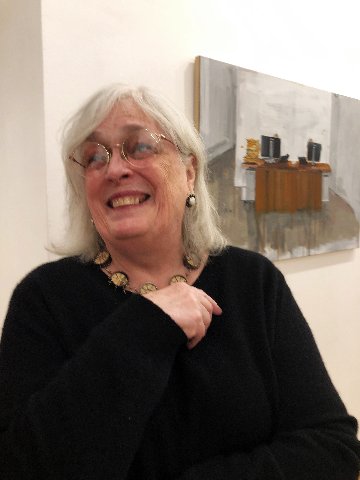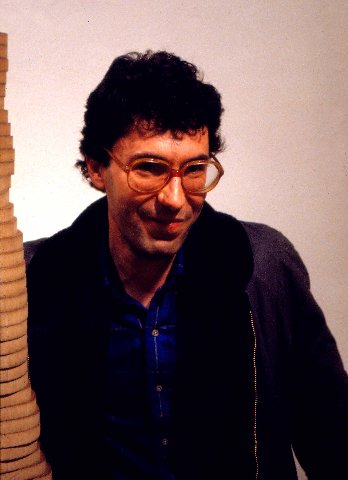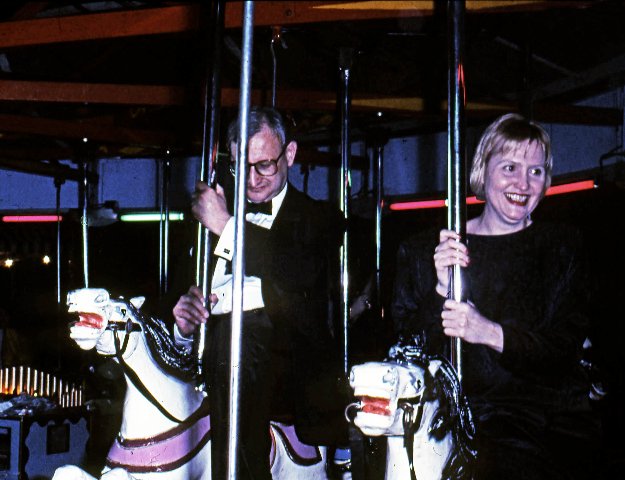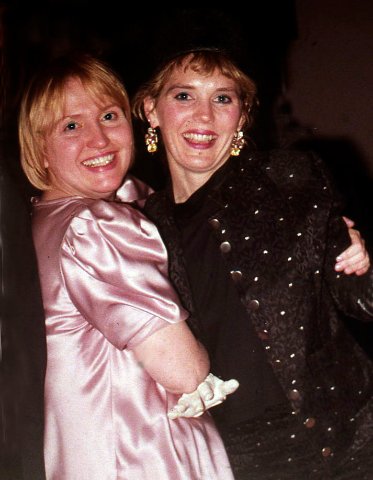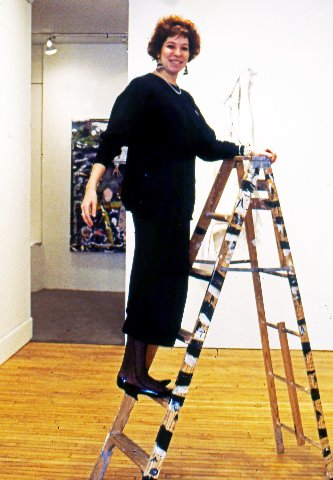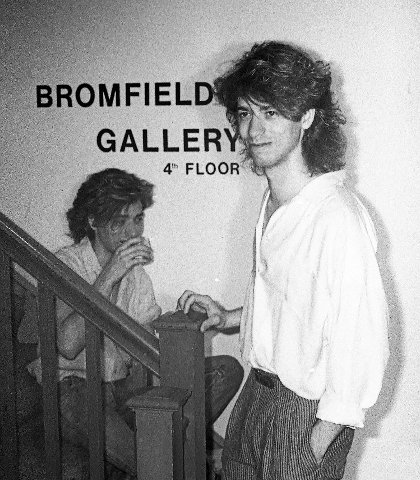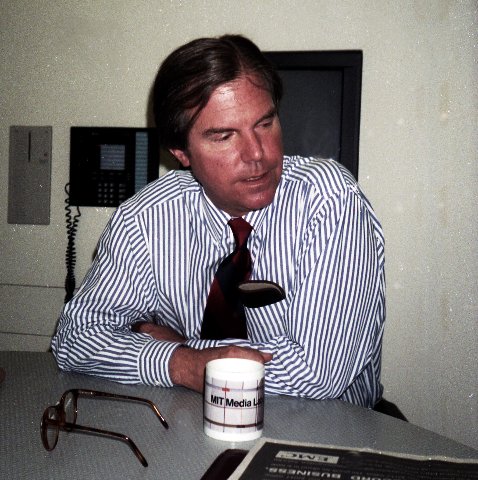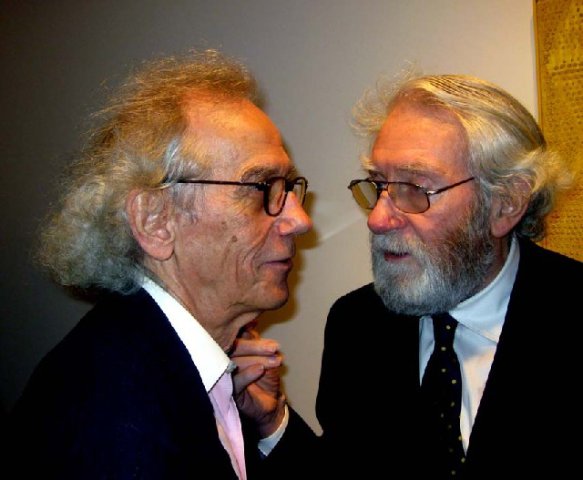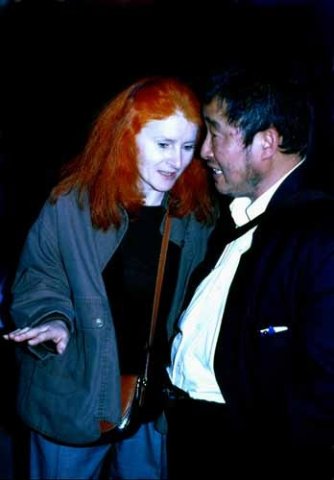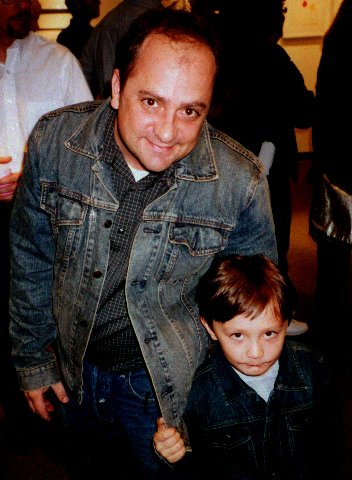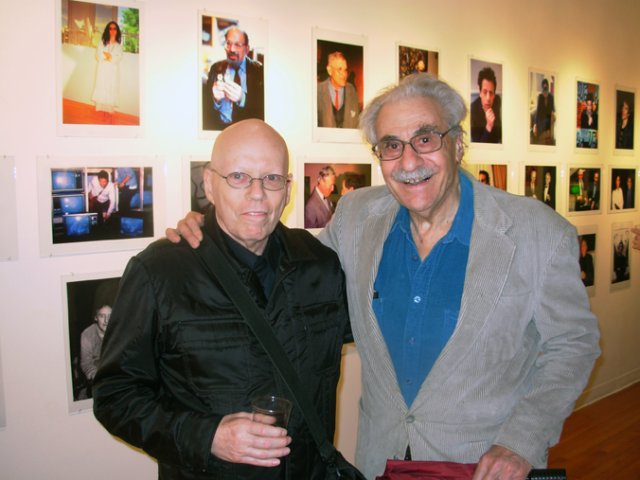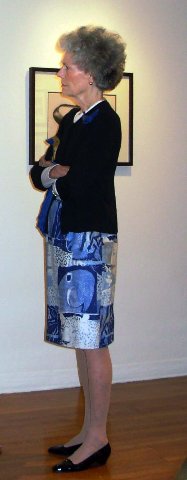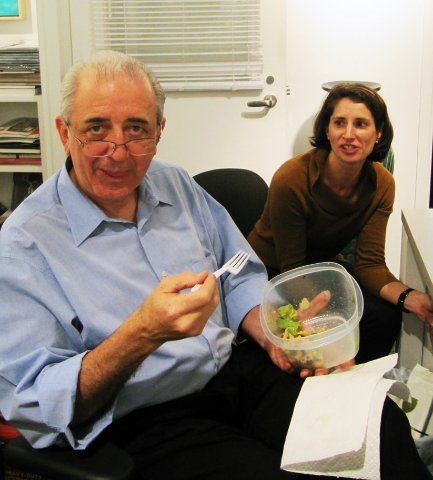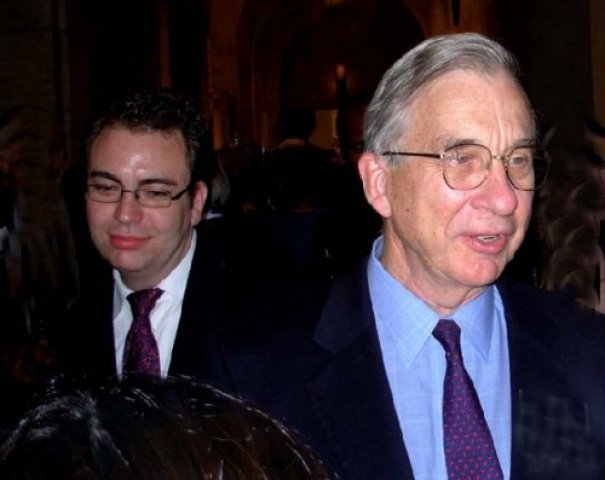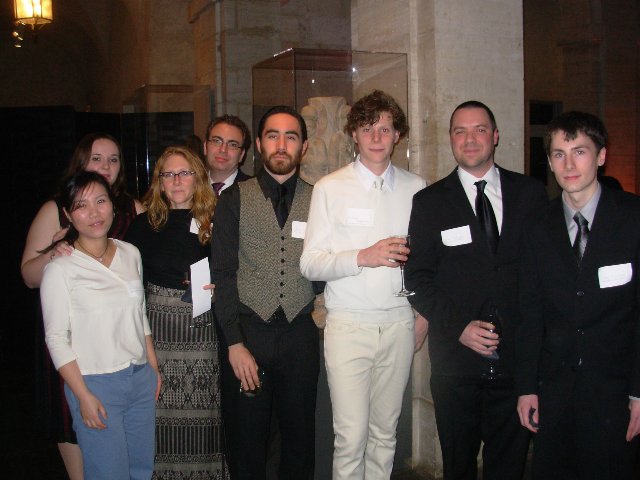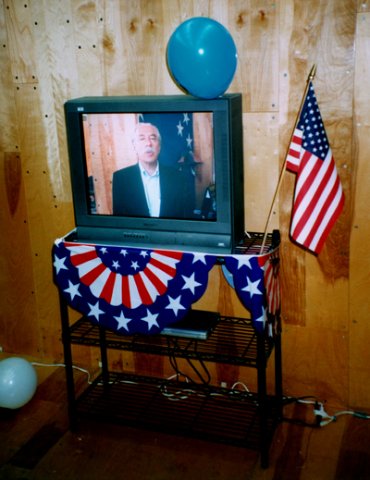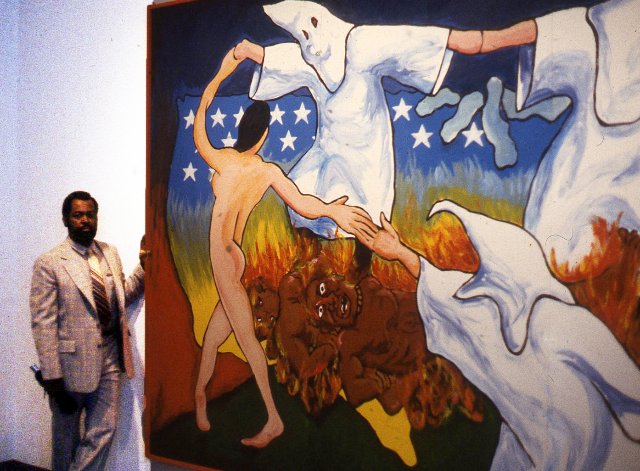Curator James Manning
Overview of Boston's Artists and Alternative Galleries
By: Charles Giuliano - Apr 17, 2020
With its many universities, colleges and art schools Boston has a diverse and unique population of emerging artists. That has equated into numerous artist-run galleries often of relatively brief duration.
Given its experimental mandate this intriguing phenomenon has evaded mainstream critical and curatorial engagement.
Left out of the equation the fine arts counterculture has little impact on the conservative and provincial perception of contemporary art in Boston.
A lively alternative scene was generated by and for artists. There was a peak period for this activity when loft space was relatively cheap. As Boston has undergone a real estate and development boom there is less of this activity. There is a shift to shows organized in popup spaces of brief duration.
In a digital age much emerging art activity has gone on line.
The full impact and global significance of Boston as a matrix for new media has been ignored. MIT’s Center for Advanced Visual Studies and Media Lab are unique to contemporary art created and exhibited in Boston.
As a young artist, curator, and exhibition installer James Manning has been intimately engaged with students, emerging artists, and alternative galleries. What follows is the first effort to document an important and ephemeral overview of Boston’s off-the-radar art world.
Charles Giuliano Your knowledge of and commitment to emerging artists in Boston is remarkable. It is matched only by Bill Arning when he was a curator at the MIT List Center for the Arts. Where did that impulse come from?
James Manning That started when I was a student at NESAD (New England School of Art & Design). Professors like you and Addison Parks introduced me to artists and many off the beaten path spaces. Addison, in particular, introduced me to a lot I never would have found otherwise. It was part of the course that he taught where the class visited galleries and studios.
We visited many galleries, among them Kingston Gallery and Bromfield Gallery, which at the time were located on Kingston Street and Bromfield Street,in downtown Boston. (Two of the oldest continual artist cooperatives which are still active.) We would end up in Allston (Rugg Road). At one point, we ended up at an exhibit a friend of Addison’s had in a loft in the Leather District. Most of these places would be open for a few months and have a couple of shows. That was the nature of the underground, alternative art scene. Addison provided my first glimpse of this world and I ran with it. I wish I had kept better notes during these trips, there is a lot of history there but the details escape me. Addison has a zine Art Deal that talked about those shows.
Some years later you introduced me to Bill Arning at one of your garden lunches, He was only at MIT’s List Visual Arts Center for a few weeks at that point. Yet he already knew more about the art scene in Boston than I did. He went to every show and met every artist. I was inspired by his drive and in my own way tried to emulate this focusing on students, emerging artists and the alternative arts scene. Bill showed up everywhere, I thought I did a lot, but he did laps around me.
(Bill Arning is now based in Houston, Texas. From 2009-2018 he was the director of the Contemporary Arts Museum Houston. Recent commercial gallery exhibitions include Stonewall 50/50 at 1969 Gallery in New York, Texas Extravagant Drawing at Fiendish Plots, Lincoln, Nebraska, Paulina Peavy/Lacamo and They Call us Unidentified with Andrew Edlin Gallery, Dirty Words-Mark Flood/Sam Jablon at Mindy Solomon Gallery, Miami, and Extravagant Drawing ReDo at G Spot Gallery and No Trigger Warnings at Bill Arning Exhibitions at Flatlands Gallery, both in Houston.
(He was at MIT’s List Visual Arts Center (2000–2009), curating shows on AA Bronson, Cerith Wyn Evans, and Kate Ericson and Mel Ziegler. From 1985 to 1996, Arning was director of White Columns in New York, where he organized first solo shows for artists such as John Currin, Marilyn Minter, Andres Serrano, Richard Phillips, Cady Noland, and Jim Hodges. His writing has appeared in Artforum, Apollo, Art in America, Out, Gulf Coast, and Parkett, and he has contributed to many international publications, including exhibition catalogues on Keith Haring, Christian Jankowski, and Donald Moffett.)
CG At NESAD’s Gallery 28 on Newbury Street he (Addison) showed a lot of emerging artists.
(Now deceased Addison was a widely exhibited artist and graduate of RISD. He wrote for a number of publications. In his last years he ran a gallery on Bow Street in Cambridge.)
JM His shows rotated at a fast pace. There would be new work on view almost weekly. I started in the art world as his assistant helping to install and working with artists. At the end of our time together he let me curate a couple of shows, which was my first experience as a curator, although these first shows were only with other NESAD students.
CG I guest curated one for him about sculpture called “Off the Wall: What a Relief.” That was shared with Crieger Dane Gallery which was next door on Newbury Street. My part included a hologram by Harriet Casdin Silver. It was a large piece that entailed an obese hermaphrodite that Harriet worked with in Belgium. Definitely, it was one of her best pieces.
As luck would have it that was hanging when administrators from Suffolk University were meeting with NESAD director Bill Davis. They were discussing a merger and Harriet’s piece was an eye opener of what they were getting into.
CG You also had your own galleries.
JM While working at Gallery 28 I interned at the FPAC Gallery (Fort Point Arts Community). I curated a show there and it was a launch for what I’ve done since. I did a group show of thirty five art students. This was my first time working with artists outside of my small sphere at NESAD and it introduced me to many artists I still know and work with today. I visited art schools all over the city. Many people thought I was a student at MASS Art or the Museum School because I spent so much time there. I wandered around studios on my own. I would talk with artists in their studios. If there was someone I liked I would knock on the door and say “There is this show that I’m doing and I like your work.” You would never get away with that today.
Once I had a core of artists to work with, I my next step was to start a gallery in Maverick Square in East Boston. Things kind of fell into place. I moved in with a roommate in a basement studio space which was perfect for a gallery. Eventually, I took it over and started a gallery called ArtVigor in the summer of 1997. It lasted until early 2000.
CG Those were the early days of East Boston. Michael Beauchemin, of Zoe Gallery started a gallery in Maverick Square. I opened my house on Webster Street as a gallery, Maverick Arts, and had some great shows. One featured Bob Ferrandini from Gallery Naga. He grew up in East Boston and we had a community talk at the local library. We had a great turnout and response for that show. Later there was an industrial space Atlantic Works which still exists.
When we moved from East Boston our three-decker sold for four times what I had paid for it. Now the ICA has a large summer space in the Jeffrey’s Point area. Boston real estate has really taken off. When I moved in it was cheap and funky. The restaurants were amazing with great taco places. We both loved lunch at Hong Kong Harbor next to the T stop.
JM Around the same time I started ArtVigor in East Boston, there were a lot of artisst my age starting galleries all over the city. There was a boom of alternative spaces all popping up at the same time. Several spaces started in Chinatown, There was Oni Gallery (1998-2004 - Founded by Cheyney Thompson, Brendon Downey and Tim Bailey, later directed by Lydia Eckles) and Gallery Insekt (1996-1998 Directed by Justin P. Moore). Nom d’Artiste (Directed by Jeff Mckenzie and Kaye Boutet) was another Chinatown space around this time. Over in the Fort Point Arts Community other spaces opened up, there was White Elephant Gallery (1996-1998 Directed by Tiffany Shea York.)
CG Why did they call it that?
JM Everyone had weird names for their spaces. I came up with ArtVigor on the spot a couple of days before the first exhibit opened. A friend of was designing a poster and realized we didn’t have a name for the space.
In the late 1990s, it was the peak of Mobius. (Founded in 1977 by Marilyn Arsem, co-directed by Jed Speare (1954-2016) They were famous for their annual ArtRagous which was an all-night art party that took over entire warehouses filled with exhibits, performers and bands. Each year it got bigger and weirder and it was always the place to be! .It was a growing scene and I fully immersed myself in it.
CG Also in Chinatown Peter Barnes had a huge space Equus Gallery. I organized a show there. For my 5Oth I hired Ferrandini’s band for a blowout party. He was a fabulous rock and blues guitarist. That was a night to remember.
Another was Absinthe Gallery in the North End. I wish I could remember the name of the curator. She organized a glass art show for NESAD. It was coordinated with a conference. We had several shows like that including when the College Art Association met in Boston. We offered a show to the related Women’s Conference for the Arts.
JM There were a ton of artist run spaces around Boston during the late 1990’s / early 2000’s . Gallery at Green St., in a T stop in Jamaica Plain (Founded by James Hull 1999-2006); Studio Soto, Fort Point (Founded by Gustavo Soto-Roso) ; Bad Girls Studios in Jamaica Plain (1996-2000 Founded by Jessica Brand). The Berwick Research Institute, Roxbury (2000-2011 founded and directed by Meg Rotzel); Crosstown Arts, North End (directed by Sandro Carella); Artist Foundation, South Boston (directed by Kathleen Bitetti, an important advocate for artists in Boston). Another was HallSpace - established by John Colan in 2006 briefly as one of the first Galleries on Thayer Street in SOWA / South End, Boston. It is now located in Dorchester, and is among a handful of galleries from that time still active and doing excellent programming.
CG One of the more interesting ones was Zeitgeist which a couple of years ago briefly moved to Pittsfield.
JM I also enjoyed Zeitgeist when it was located in Cambridge, I considered them an extension of the counter-culture movement with radical poster exhibitions, jazz shows, poetry slams and even a small pirate radio station.
Another key organization was the Revolving Museum. They occupied most of a six floor warehouse in Fort Point with dozens of studios and gallery spaces. they had everything from exhibitions, Kaiju Big Battel (a mash up of wrestling / Japanese monster films), performances and film festivals - all inside a building with a thriving community of dozens of artists.
An offshoot in one of the unused studios of the Revolving Museum was the Little White Box Gallery, which I curated a few shows for.
CG The Revolving Museum was founded in 1984 by Jerry Beck who was an early master of popup projects. One that I covered entailed installations in a series of railroad cars. The museum is now part of the artist loft movement in Lowell as well as Fitchburg.
In 2019 it was reported that “Last year Massachusetts artist and Revolving Museum founder Jerry Beck aimed to break the world record for largest paper airplane with a jet-shaped sculpture covered in art that flew high above a Fitchburg airfield and signaled his town’s economic rebirth. This year, he’s lifting youth voices and community ideals across New England by driving a refurbished 1952 Ford pickup truck and trailer enveloped in poems created by students and well-known writers. The colorful, interactive ‘Poetry Mobile’ comes to Boston’s Downtown Crossing on Monday and Tuesday, Aug. 19-20, from 10 a.m. to 6 p.m. at the corner of Summer and Washington streets.”
JM A bit later on as the scene matured another important space that opened was Art Interactive, 2004-2009 which Chuck Lewin (son of a renowned MIT physics professor) founded in Central Square, Cambridge.
CG These alternative spaces represent a different view of art than seen in mainstream galleries. For the most, part the fine arts of Boston are regarded as traditional, rooted in painting, and generally provincial. That narrow view was reinforced by the coverage of Boston critics. Established writers never sought out or wrote about alternative galleries. There is a lot more to consider in Boston than painting and Boston Expressionism. The experimental art of the Center for Advanced Visual Studies and Media Lab at MIT had global impact but got little or no coverage.
JM Art Interactive is an excellent example of that discussion. At the time Boston artists were involved with new media and technology-based art. Through CAVS and the Media Lab at MIT artists were involved with those developments. In general, technology was rapidly developing in the late ‘90s. Video and interactive art were becoming viable expressions. Art Interactive was known for its frequent collaborations with the Collision Collective - a group made up of scientist, engineers, writers and artist - many of whom were affiliated with CAVS and Media Lab. They were part of the DIY / Maker Scene and doing really amazing exhibits with new technology like GPS augmented and virtual reality years before anyone had this tech on their cell phones.
CG It was not being shown in galleries and museums. I recall early video art which was produced with B&W, reel to reel, security surveillance systems. When I covered Bill Viola (for Art Ne an early ICA show he was using tape. A few years later, when he did an installation at Fuller Museum of Art, he discussed how the work had evolved to CD’s. His work followed the curve of developing technology.
JM Of course we cannot talk about media and technology art without mentioning George Fifield, one of the important figures in that scene, in the early 1990s. He produced exhibits for “Video at the Space” at an alternative arts center. His work on these shows eventually evolved into Boston Cyberarts Festival.
I never saw the shows myself, as it was before I was active in the scene. I was constantly hearing about it from artists. It influenced my views of the connections between technology and art.
Eventually. I got to know George and worked with him many times over the years, including most recently, on a series of exhibitions he curated at Emerson College.
(Fifield founded the Boston Cyberarts Festival and was an adjunct curator for the DeCordova Museum from 1993 to 2006. He was an Art New England columnist and now runs Boston Cyberarts Gallery in what was formerly the Green Street Gallery in Jamaica Plain.)
Because of a personal interest in media and technology that informed my own art. Back in art school, I was experimenting with computers and trying to figure out what to do with them. As I became involved with the art scene technology started to be a part of the artistic language. Initially, with my spaces I was still involved with traditional approaches including painting, printmaking and sculpture. Back then I did not have enough knowledge of the new media to curate it.
But I was involved and Art Interactive was one of the spaces where I took off as an exhibition installer. We were installing complicated tech exhibits. But Art Interactive didn’t lose touch with its roots. One of the more memorable shows was Do It Yourself Fluxis (2004) which featured an evening of original Fluxis performances led by Larry Miller and others. There was a balance between historical art that developed in the 1960s and 1970s and attempts to show that in context with all the hot new technology that was happening at MIT.
Another notable exhibition was Art Show Down - curated by Jeff Warmouth and Roland Smart- where we turned the space in to a television studio and staged an arts themed game show which was actually broadcast on CCTV, the cable access channel in Cambridge.
CG With a big space easily accessible in Central Square, Cambridge Art Interactive was on the high end of alternative spaces. It was a program with unique curatorial focus. Considering the quality of innovative work being done it didn’t get wider media coverage and is now largely forgotten. Part of the attempt of my oral history project is to create an archival memory of so many unique efforts. There is little accessible documentation of important work and experimentation.
Even for the ICA, for example, there is no place on its website to get the most basic information. There is no inventory of its exhibitions. It has been challenging to create even sketchy sequences of curators and exhibitions. That is irresponsible for a seminal museum which has the resources to create that information and access. It is confounding that the ICA displays such indifference to its institutional history.
There is no comprehensive publication on the history of the ICA. For its 50th anniversary there was an exhibition and catalogue “The Issue of Modern Art in Boston.” The ICA was founded in 1936 as The Boston Museum of Modern Art. The anniversary show focused on the controversy of when the ICA severed ties with the Museum of Modern Art and changed its name to Institute of Contemporary Art. The other major show of that occasion was “Endgame: Reference and Simulation in Recent Painting and Sculpture” a conceptual then and now theoretical project.
At the time there was a plethora of alternative spaces. Most were so ephemeral that the struggles to exist precluded documentation. Major aspects of Boston’s contributions to contemporary art are unknown. The wrong assumption is that little or nothing of importance was happening. Ignorance sustains notions of art in Boston as traditional, conservative and provincial. The scene we participated in, and contributed to, was much more dynamic.
JM Mobius was focused on performance and participatory art. Mobius, in a sense, was the opposite of Art Interactive. It was low-fi and low-tech. With performances and body art there was more one-on-one interaction with the artists. They had big openings and maintained a large studio at Fort Point. There was a contrast with Art Interactive which focused on technology. Mobius which once had extensive facilities on Congress street, still continues today having moved to several ever-smaller locations. It is now operating nomadically out of a small storefront space in Central Square in Cambridge.
Oni, Berwick and all of these organizations have had a rich history of exhibitions, artists and events. It is really shocking to me how little documentation there is out there about them. There is an important story that needs to be told, many spaces and exhibitions which unfortunately may never be remembered.
This was something I was aware of early on, there was no place to get even basic information, unless you were there at the time or knew the participants.
I did my best to capture and preserve these moments that I witnessed. I had a column on Big Red and Shiny (website) where I documented many exhibitions, performances and events. (Established in 2004, Matthew Nash was the original publisher with Matthew Gamber as Editor in Chief, Big Red has since transitioned to a different editorial team)
CG I collaborated with (Big Red and Shiny) on a show about money as theme and material in art. It was a one-nighter for a benefit at the Boston Center for the Arts (Big Red and Green, January 8 2005). We invited them to expand the exhibition at NESAD. (Return on Investment August, 2005) Sheppard Fairey, then a student at Rhode Island School of Design, was one of the artists included.
Who were some of the artists you worked with over the years?
JM Although I am probably known most for my work with students and emerging artists, I have also worked with many more established artists who are known in the Boston community. It’s hard to name just a few as I have worked with so many, but in no particular order, Jeff Warmouth, Matt Nash Catherine D’Ignazio, Jeff Smith, Lina Maria Giraldo, Keith Francis, George Friedman, Chuck McNally, Brett Angell, Amy Ross, William Freese, Linda Leslie Brown, Reese Inman, Harry Bartnick, Mike Hammecker, Heidi Marston, Jeff Heyne, Amanda Palmer, Don Harney, Liz Nofziger, Fredo Conde, Jim Kalambokis, Don Eyles, Jeff Smith, Bebe Beard, Melora Kuhn, Eric Legacy, Meryl Hamilton, are just a few of the many great and talented artist I enjoyed working with over the years. I would also note several artists - Ralph Hamilton, Lou Cohen, Paul Laffoley, Paul Andrade and Kirstin Malone- among those no longer with us.
Some of these artists have had successful careers while others may not be active today, but each of them contributed greatly towards exhibitions I have curated.
I am missing many important people with such a list but I think these would be some of the ‘highlights’ in my opinion.
CG That constant migration was also true for commercial galleries. There were early efforts to find alternatives to Newbury Street. My first exhibition, in 1963, was at Hoffman Youngaus Gallery in Cambridge. My second was at Seymour Swetsoff’s frame shop and gallery on Mt. Auburn Street. There were other Cambridge galleries like the African American focused Wendell Street Gallery. For a time Cutting/ Brazelton/ Van Buren on Huron Avenue was an important space. The private dealer Barbara Singer represented Maud Morgan, Todd McKie and other artists. There were openings in her home.
As rents soared on Newbury Street there were efforts to establish other gallery districts around South Station and the South End. There were galleries in the Leather District near Chinatown as well as on Congress Street. The artists buildings on A Street and 300 Summer Street, as well as Brickbottom, in Cambridge have important galleries.
One of the first artist/loft galleries was The Atlantic Gallery opposite South Station. The video artists and musicians Jeff and Jane Hudson divided their space to live and show work. The artist/musician Paul Shapiro lived on the other side of the partition. Jeff and Jane founded the video and new media program at the Museum School. They also had a punk band The Rentals that famously opened for The Clash at the Harvard Square Theatre.
The Italian avant-garde dealer, Mario Diacono, who now lives in Brookline, had several different locations. He was known for presenting a single work by artists with global reputations. For each show he wrote philosophical essays which were handouts. I have a number of them saved in my archives.
JM I remember a lot of those galleries. It was easier back then with plenty of large spaces available around the city and rents very affordable, even for young artists. In some instances, galleries would take over entire buildings almost to excess. At one point they were all over the city and it was a problem to get to them and keep up with the activity. The gallerists and curators never talked with each other so there was not much coordination. I am was among the few who actually tried to keep up. At the peak a typical Friday for me would be starting out at a few openings on Newbury Street, then run over to JP, ending up in Cambridge, then back over to Chinatown or Fort Point for loft parties.
I made a habit of getting to all these spaces. Another memorial one, performance artist, Cynthia Von Buhler, had a house which she called The Castle in Allston. She later operated an alternative gallery in Chelsea, NY.
CG I first met Cynthia when she modeled for a multi-media collage by Greg Garvey a NESAD instructor. He got a gig in Montreal teaching new media. Cythia’s imagination and energy were astonishing. I had work in one of her shows. When she moved to New York there was a sale and I bought couple of her pieces. She and her band performed with Karen Finley at The Paradise. Finley flopped around naked on stage and invited the audience to pour honey over her. Then there was a party back in Allston.
Congressional outrage ocured when Finley and “Piss Christ” artist Andres Serrano won NEA grants. Senator Jesse Helms ranted and pushed through legislation that ended individual grants to artists through the endowments.
There were so many great shows that went undocumented. Lopoukine/ Nayduch on Congress Street had “Manet” a minimalist Carl Andre show. There was a gallery talk disrupted by the artist Michael Russo a former union organizer for the CPA. Andre grew up in Quincy which is known for granite. The city motto is “Manet” Latin for “It Remains.” The show was a grid of vertical granite blocks.
JM A lot of the spaces started with students from Mass Art and the Museum School. Zach Feuer was at the Museum School when he turned his apartment into a conceptual art gallery. Zach also curated Kid Pix, an exhibition of computer generated art at Gallery FX, a student focused Gallery I ran in SOWA (1999-2001) Zach went on to run a very successful New York Gallery (2000 to 2016).
CG When he first moved, I used to visit his space on an upper floor in Chelsea. He was showing a lot of artists, including friends from Boston, in flat files. He went on to have artists in major shows like the Whitney Biennial. Pace and Brent Sikkema are other major New York galleries that started on Newbury Street.
On your watch give us a thumbnail of the Boston scene.
JM There was a 5-year period when it was very active with numerous events every week. Oni Gallery in Chinatown was a hub of that. It was run by a collective of artists. After moving several times they eventually had the 5th and 6th floors of a building in Chinatown, where they had a two floor exhibition space, a black box stage, lined with studios - and of course no working elevator. They hosted everything from salon style exhibitions with over a hundred readings, music performances, book clubs and meetings for all sorts of groups. It was constantly active. They had ambitious programming including bringing in artists from New York. They even got NY press which was unheard of. Art Forum would come and look at what was happening in alternative spaces.
CG Now deceased, Francine Koslow Miller wrote on Boston gallery shows for Art Forum but selectively reviewed Boston artists. Previously, Nancy Stapen (also deceased) covered Boston for Art Forum. For a number of years, I was Boston correspondent for Art News contributing capsule updates.JM
JM Another key organization was the Berwick Research Institute in Roxbury. They were another collective of artists. They had a small gallery space and studios but their main focus was on public art. They ran a very successful artist-in-residency program focusing on Public Art projects around Boston.
It was amazing to have such diversity from large collectives putting on massive exhibits to others like myself basically running a space on their own. We all coexisted over this short period in the late 1990s early 2000s. While there were rarely formal collaborations between different galleries and organizations, I think we were all supportive of each other’s efforts. There were several attempts to establish a formal network connecting everything but none were particularly successful.
When the Democratic National Convention was held in Boston, in 2004, I helped coordinate a promotional effort for several alternative spaces with politically focused shows.
CG You curated one of those shows Give Me Some Truth for our NESAD gallery. It was an outstanding exhibition and we got better that usual response. Which was great as it was a summer show when there is not a lot happening.
JM There were eight galleries that participated in that project including NESAD, Art Interactive, Berwick, Zeitgeist in Cambridge, FPAC, JP Art Market etc. That was one of my efforts to create a sense of community.
We tried different things including a website with an interactive map to locate all the different spaces. By the time we launched the website a dozen new spaces opened and just as many had closed. It was impossible to keep up to date with so many spaces turning over so rapidly.
CG You ran a gallery program to promote work by student artists.
JM That was Gallery FX which I ran 1999-2001. I started as a volunteer when it was known as First Expressions and quickly managed to become the director. I changed the exhibitions format from a boutique space showing students from each school separately, to a format where for each show I mixed students from all the art schools in the city. I would also alternate with guest jurors - Charles as I recall- you were a guest juror for a drawing show. A couple of the more memorable shows included Dirty Pixels, an electronic arts show part of the 2001 Boston Cyberarts Festival and Toy which featured a performance of an orchestra made up entirely of toy instruments.
Changing this format greatly expanded the audience, and exposed many students to work made by peers at other schools. We even got an occasional write up in the Weekly Dig and Boston Globe. It also annoyed the administrations of all the participating schools who promptly withdrew their funding as they did not want to sponsor exhibitions which involved students from rival institutions. I had a supportive Board of Directors and stuck with it for 2 years despite the lack of funding.
Gallery FX was part of the first group of galleries in the SOWA district (South End). That also included Genovese/ Sullivan and Bernie Toale. Then Kingston moved to join us. There were four or five spaces for the first couple of years. It was pretty desolate at the time.
Nothing was yet developed and the street was still raw warehouse spaces. Nobody knew about us. Toale and Genovese/ Sullivan had clients who visited. But we were unknown. Nobody was buying anything from me. As I had done previously, I looked for ways we could work together. Once a month we would meet and plan. Out of that came the idea for a First Friday event. Prior to that, we were all having different openings.
The first time we tried it, it was a huge success. Eventually, GTI Properties redeveloped the entire street and opened up dozens of new galleries, studios and shops. Today First Friday has become an institution and is the center of Boston’s Gallery scene. By the time this happened Gallery FX, had long closed.
The scene continues to evolve, I think one of the biggest changes has been the emergence of art fairs, the business model changed. The SOWA gallerist, Camillo Alvarez, for example, was on the road so much that he closed Samson Gallery.
In more recent years, there has been a newer generation continuing on the tradition of the earlier artist run spaces including, among the ones I found most interesting: Axiom (2004-2012, Founded by Heidi Kaiser, co-directed with Phaedra Shanbaum, originally in Allston, then Inman Square Cambridge and finally Jamaica Plain. LotF Gallery (2009-2018 founded in 2009 by Kate and James Wormser, Downtown Boston); Proof Gallery (2007 -2017 directed by Kara Braciale and Julia Hechtman, South Boston); The Forth Wall Project (2010–2014, Boston) and MEME (2009-2011 Founded by Alice Vogler, Vela Phelan and Dirk Adams, Central Square, Cambridge.)
CG We first met when you were a student in my art history class. Neither of us recall much about that. Our relationship started when working together in the gallery program. Addison passed along to me the job as gallery director. There was resistance by the department chairs who wanted a woman promoting feminist “Victim Art” programming. Addison went to the school president, Bill Davis, and insisted that I get the job. Bill was very supportive of our program which was completely independent.
During a meeting there was an attempted coup by the department chairs. They wanted to mandate their own shows that I would curate for them. Bill listened then said “I think Charles is doing a fine job and let’s leave things as they are.”
My mandate was to show the best, mostly mid-career Boston artists. Your domain was emerging artists. We also managed to show New York and European artists. Through Suffolk faculty contacts we showed Vietnamese and Latin American artists. I showed the NY artist, John L. Moore, the French painter, Rafael Mahdavi, and German, Group Zero artist, Otto Piene. Late in my tenure, I had a group show “Native New Yorkers.” There was a solo show with Jaune Quick to See Smith. She gave a slide show of contemporary Native American Art to a Suffolk student assembly. Jaune also gave a gallery talk and made classroom visits. Given a few more years I would have done more programming in that generally neglected field. Jeffrey Gibson of Samson Gallery is now well known. I interviewed him in his NY studio as I did other Native American artists. When we toured Canada last fall, we saw a lot of First Nations work in museums.
Then we opened the Project Space in a corridor so we were putting up two shows a month. Overall, I think we had one of the best programs in the city. There were also annual student and faculty shows.
During the summer season, you curated an annual show of emerging artists which we called “Star Search.” We were experimental during the off season. One artist complained about showing in summer. I discovered her, then unknown, during open studios. That show, which got a Globe review, gave her a boost and she later won the Maud Morgan Prize at the MFA.
Not every effort panned out. There were times that artists just didn’t deliver or made outrageous demands. We did a London-based show “Five Artists from the Royal Academy” and the guest curator, a gallerist, insisted that students not be allowed to have coffee breaks in the gallery. She visited the show regularly for a few minutes, charged us to park her car in a garage, then went shopping. In London I made studio visits with the artists and she loaned the work.
Abe Lubelski, publisher of New York Arts Magazine, strung me out about what he planned to show. He showed up, asked for a can of black paint, a brush and ladder which became part of the installation. On the wall we wrote “This Show Is Cancelled” then underneath the reasons why.
A faculty member took the can of paint and scrawled “Bullshit” on the wall. I was home when you called me that everyone was in an uproar. I thought, then and now, that it was a conceptual piece and good lesson for our conservative art school.
Another important show was Los Tres Grandes: Domingo Barreres, Gerry Bergstein, Bob Ferrandini. Just before we installed Bob had a stroke. He insisted on being included but wasn’t able to come for the opening.
We did a major Beat Generation show coordinated with Linda Poras of the Brush Art Gallery and Whistler House during the annual Kerouac Festival in Lowell. For that show I got loans of works from collectors and galleries. I had arranged for works by Allen Ginsberg but he died just before the show. His gallery, and Elsa Dorfman who photographed him, withdrew at the last minute. I showed their work from my collection and borrowed a lot of images of Beat poets from Gerard Malanga. There was a piece by Lawrence Ferlinghetti. We had readings and events related to the show and professors brought their classes.
JM When I did a political themed show during the summer of DNC you suggested that I visit the studio of Arnold Trachtman. He was an important and fascinating artist. He connected me with Dana Chandler and I included both of them in the show. I thought this was a great counterpoint and balanced my exhibition including these established voices from an older generation alongside a group of younger more idealized artists.
I was intrigued by the mix of emerging and established artists. At ArtVigor I was showing students as well as their teachers. For the most part, that was a very positive experience. I tried to make the openings interesting. If someone was going to come to East Boston I should make it worth their while. I had bands play at my openings,with readings or performances. At one opening, I had Billy, the NESAD receptionist, who performed in drag as Crystal Crawford. Some of the guests were freaked out by that and I think I lost friends that night because it was too weird for them.
I was inspired by one of the more bizarre incidents at NESAD some years before during a show that Addison curated. In the middle of an opening two people, one an earlier receptionist at NESAD, came out in full S&M black leather gear. She was a dominatrix and her dog on a leash. She lashed his but till it was red and raw. After a few minutes she rode off on his back as he crawled out on all fours. Everyone was speechless. The next day I saw Anita, the school’s accountant splashing Holy Water around the gallery saying a prayer.
CG We had great openings which helped to build an audience. I became a master of finding three-for-ten wine at Kappy’s. The gallery rats showed up mostly to drink and snack. Some guys we had to deep six. I would start shutting down the bar but people didn’t want to leave.
You went on the develop a career as an exhibition installer. Tell me some of the spaces you work with?
JM I was an installer for Art Interactive where I worked on nearly every exhibition they had. I’ve done a lot of work with Boston Cyberarts over the years. Through Bill Arning, I started working on exhibits at MIT List and continue working with them today. I worked on some shows at the ICA when they were located on Boylston Street, and the Rose Art Museum at Brandeis.
I moved up in the installation world. I focus on new media, video and technology installations and a specialist in that area. There aren’t a whole lot of us who focus on tech installations. These days, I probably spend more time reading tech manuals and keeping up with the latest technology than I do following the art world.
At first it was very part time. I would work for a week or two then be on my own doing odd jobs outside of the art world for a couple of months. But eventually things picked up to the point where I have a full-time business not just installing exhibitions but also doing video production as well.
Most of my work today is at Emerson College, which is where I ended up after my gig at NESAD. When you retired, I took over as gallery director at NESAD / Suffolk for a year and had a terrific well received run of exhibitions. I was probably at my best as a curator at that point. But they wanted to go in a new direction and hired someone else when my contract expired in 2008.
Immediately after I was let go by NESAD, I was contacted by Joseph D. Ketner (1955-2018) who had just returned to Boston after a few years in Milwaukee. (Previously he was also the director of the Rose Art Museum at Brandeis.) Joe had been hired as the Foster Chair of Contemporary Art and Curator in Residence at Emerson College and he brought me on as his assistant. We worked together for ten years as he established Emerson’s exhibition program culminating with the opening of the Media Art Gallery in 2006. Perhaps the most notable exhibit was William Kentridge: Triumphs and Laments, 2018. Joe passed away just a few months after that show.
CG Let’s talk about the annual student art show that was started by Arthur Dion.
JM The Stephen Paine Scholarship. At the time Arthur was head of the Boston Art Dealers Association. They worked with Stephen and Susan Paine to establish a scholarship. It was for undergraduate students of art schools in Boston.
They approached me to host the first show of recipients. At the time, I was running Gallery FX in SOWA. It was quite a success. It was a continuation of what I had been doing working with student artists. They were planning a 20th anniversary but it was cancelled because of the pandemic.
After Gallery FX closed, for a couple of years, it went to the Copley Society. I was kept on as a consultant because of my work with students. Then we brought it to NESAD for several years. What was important to me was having students from different art schools showing together.
CG By the second show at NESAD you had so much work to hang that we opened up the entire school. Work was hung in an adjacent studio as well as in the halls. There was work everywhere and that resulted in a huge opening and steady traffic. That really put NESAD on the map among Boston’s art schools.
JM The school was expanding and took over more space. Wherever possible I claimed walls to hang work. The Project Space and that adjoining gallery became a part of our expanding gallery program. It was great to have breathing room when we did bigger shows.
CG Jane Hudson invited me each year to talk to her grad students at the Museum School. From the students I met some we invited to have Project Space shows with us. That extended our reach. One student, Serena Kahn Reddy, had an installation about Disneyland. For the videos she bought TVs and borrowed tape decks from the Museum School. After the show she returned the TVs for a refund. Serena had been my art history student at U. Mass Lowell. Her father had insisted she become an engineer but my class aroused her passion for art. I convinced that her knowledge of technology would make her a strong candidate for the Museum School. I took great pride in the chance to show her work.
JM I also guest lecturer in Jane’s class a couple of times. That was a trick of the trade for young artists. You could buy stuff at Best Buy or Home Depot and return it a month later after your show was done.
I always appreciated that Jane was one of the few professors who taught how to actually survive in the art world. Not just theories or technique but actual skills like how to present work to a dealer, install an exhibition, and build real connections in the art world.
CG Uniquely to art schools it was common that our former students to became friends and colleagues. That often was a part of wanting to look after your wellbeing. For future security some of us prevailed on you to enroll in Dan Ranalli’s arts administration graduate program at Boston University. Did that prove to be worthwhile for you?
JM Absolutely. I don’t regret having a master’s degree in arts administration. I had worked with a lot of the people teaching the classes. I’ve been asked this before and I almost consider the experience like Finishing School. I was already working in the field but needed some polish to turn it in to a career.
CG When we visited the Fitchburg Art Museum last year for Fire and Light: Otto Pienne in Groton 1983-2014 (curated by Lisa Crossman) we saw your name on wall labels. You were credited with a lot of the video work. How did you come to work with him?
JM That came through John Powell (1943-2020) who was one of Otto’s studio assistants. I had worked with John for years as his studio assistant. I got involved with helping out at Otto’s farm / studio in Groton, MA. Joe Ketner was also involved as an advisor for Otto’s collection, so the three of us (John, Joe and I) spent a lot of time working together during Otto’s final years and continuing after with his estate.
I only got the chance to work directly with Otto on a couple of projects before he passed, the most notable was the MIT 150th anniversary celebration. Otto did a Sky Art event with a 125 foot tall inflatable sculpture performance in the main courtyard. I spent the day there and made a really great short video capturing the event. That video was included in the Fitchburg Museum exhibit.
Even after he passed John and I kept working with the estate and his widow Elizabeth (Goldring Piene). The show at Fitchburg was the culmination of all that. For that show, Besides including my video of the Sky Art event I worked on recreating a video installation Proliferation of the Sun that Otto has completed as part of his final exhibition just days before he passed.
I have the opportunity to work with a couple of important artists that I learned about through you. At NESAD you did a show with Otto. (Large scale drawings)
CG You were constantly photographing and making videos. What will become of that archive?
JM It took off with Big Red and Shiny. I was the one with a half way decent digital camera which was still a rather new thing at that point, so I took pictures at openings and events to post on the site. Eventually, I had a column called “On the Town.” It was probably the liveliest feature of the site because everyone loved to see pictures of themselves. This was long before Facebook, Instagram and all the social media and call phone cameras in every pocket. There were many exhibitions that very likely I was the only one to document.
Over the years I have tried several times to put together some kind of accessible archive. Unfortunately, for various reasons it’s never really taken off. I had the ambition to make a film or documentary about the Boston art scene. It is definitely a goal for the archive to have a lasting presence. Right now, it’s all in boxes in my office.
CG Are the files organized in a manner that you can find things?
JM Sure. Especially photos and videos, although there is still more I can do with it. The big question is where do I put it and where does it go and who would be the audience?
When Big Red and Shiny was at full speed that was my primary job. It was pro bono but I was going to eight or ten openings each week. It was a ton or work between posting and captioning all the photos and writing summaries of each event. It was very time consuming.
CG But it gave you a lively social life.
JM Sure. That was a big part of it. There was an outlet to post pictures but it was what I was doing anyway. I did that for years. My life was pretty much about going to art openings.
CG What is it like today? The sense is that those alternative spaces are now few and far between.
JM Those places don’t exist because everything got priced out. When I started out in Fort Point, you could rent an entire floor of a warehouse for $1000 a month. Now that wouldn’t rent a closet.
Another big shift was the emergence of social media. When I started with Oni we went out at night and put up posters all over the city. Nobody does that anymore, get out in the street. You just put something on Facebook and 10,000 people know about your show. The art fair culture took off. A lot of dealers exist only on that network. It’s the most efficient means to meet their clients. It has become secondary to have a physical space.
CG Now with galleries closed as non-essential business there is another shift. There are virtual exhibitions on line. That may be a video walk through or slide show. Strategies are emerging for artists and gallerists to promote new work.
When the pandemic winds down the art world will be very different. Museums are struggling while commercial galleries and alternative spaces are likely to be devastated. Even the hospitality industry which artist rely on for income has been overwhelmed.
JM With media changes artists no longer need giant warehouses to show their work. You can have the same result on your laptop.
Over the past few years in Boston I’ve seen a lot of popup galleries. At downtown crossing there has been a series of those shows. You get a space and have a show for a month. Which is not that different for the former alternative spaces. You get in, do your show, then get out. It’s more about social media marketing. That’s the evolution I see.
In Boston I don’t think it’s possible to maintain large spaces like Oni and what Mobius once had. Now Mobius has been nomadic and is down to a storefront.n their own way they are still thriving and perhaps more important than ever in a smaller community of organizations..
There has been an evolution in how art is made and presented. I’ve been in the thick of that. I don’t often get nostalgic or dwell on the past, but recently while being isolated with the current social distancing, I’ve been going through my archives and have enjoyed looking back at all the crazy shows I was a part of.
CG With the arts at a standstill because of the pandemic how will you survive?
JM At the moment I’m working at home for Emerson. Mostly we’re planning for summer but almost every day there is a change and delay. It’s interesting that you ask me about archives. Right now I am working to rebuild and establish a proper archive for the Emerson exhibitions that the current curator Leone Bradbury has done over the past year. Eventually we will establish a full archive including all of the projects Joe did there as well.
When you and I first started talking about this project last year that got my gears going. I started to think about organizing all of my exhibition flyers. When I went to all those shows I collected every handout I could find. That includes check lists, postcards, artist statements and all sorts of memorabilia. I’ve got boxes and binders full of them. It’s a time capsule of an era. But I never stopped and got nostalgic. After I left NESAD I stopped curating but with my degree I am working more on my business as an exhibition designer/ installer and focusing in on arts administration side of things. You just have to keep moving and evolving. Something new will come of this and the challenge is to stay on top of what develops.
Frank Conte coverage of Art Vigor.


